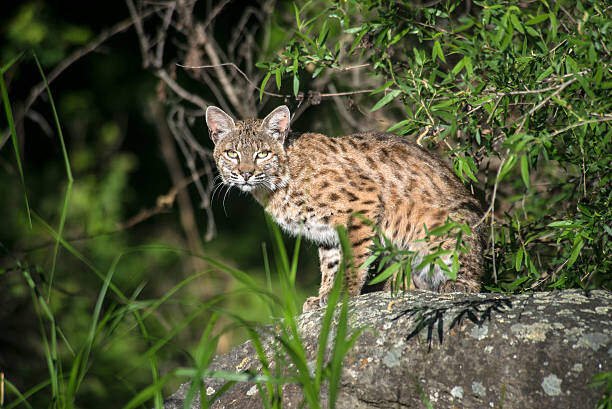Do Bobcats Have Tails?
If you have ever come across a bobcat, you might wonder Do bobcats have tails? With their beautiful nature and stunning appearance, bobcats have captured the fascination of many people.
Are you ready to learn more about bobcats and their tails? Keep reading to discover fun facts about these medium-sized North American cats.
How to Identify a Bobcat

The bobcat is a popular wild animal species in North America known for its unique appearance and secretive behavior. To accurately identify a bobcat, it’s important to look for the following key features:
- Size
Bobcats are medium-sized cats, with males typically larger than females. On average, they measure about 28 to 40 inches (71 to 100 cm) in length, excluding their short, bobbed tail, which is typically 4 to 7 inches (10 to 18 cm) long. - Coloration
Bobcats can have a wide range of coat colors but typically have a tan or brown base with black or dark-tipped markings. The coloring serves to help them fit with their environment. Their coats can also be a subtle shade of crimson or gray. - Spots and Markings
Bobcats are easily recognizable by the dark spots and markings on their fur. Cats’ stripes and spots tend to cluster together in odd patterns, and their intensity varies from one animal to the next. - Ears
Bobcats have tufted ears with black tips. These tufts of hair, also called ear furnishings, are a distinctive feature that helps distinguish them from other small feline species. - Facial Features
Bobcat’s face are distinguished by their short, stocky nose and large, bushy cheek ruffs. Their long, sensitive whiskers help them find prey and find their way through the wilderness - Eyes
Bobcats’ eyes are either yellow or greenish-yellow, and their pupils are black. They have adapted their eyesight and night vision to the darkness as a result of their nocturnal hunting habits. - Body Build
Bobcats have a sturdy, muscular body and short legs in comparison to other cats. They excel at stalking and pouncing on prey, which is mainly rodents, birds, and other small animals. - Behavior
While observing a bobcat, take note of its behavior. Bobcats prefer to hunt alone and are notoriously difficult to spot due to their stealth and evasive nature. In North America, if you see a cat-like animal with these characteristics, it’s probably a bobcat. - Geographic Range
Bobcats are found throughout North America, from southern Canada to northern Mexico. They are found in many different habitats, from grasslands and wetlands to forests and deserts.
Keep in mind that bobcats of the same age, gender, and geographic area might look very different from one another. The above characteristics allow you to positively identify a bobcat if you happen to see one in the wild or nearby.
Read also: What You Did Not Know About the Viral Baby Bobcat
Are Bobcats Aggressive?
Bobcats are generally solitary animals, preferring to avoid interactions with humans. While they may exhibit defensive behavior if cornered or feel threatened, they are rarely aggressive toward humans without provocation. With proper precautions and respect for their space, encounters with bobcats can typically be peaceful.
Do Bobcats Have Tails?
Yes, bobcats do have tails. Their tails are typically short, measuring around four to seven inches in length. These tails serve various purposes, such as providing balance while maneuvering through their habitats and communicating with other bobcats through expressive movements.
Read also: Why Is the Monkey Tail Cactus a Recommended Plant?
What Does a Bobcat’s Tail Look Like?
A bobcat’s tail is distinguishable by its short length and unique appearance. It features black fur on top and a white underside with black bars or stripes. The tail’s black tip adds to the bobcat’s striking visual appeal, contributing to its name.
Do Bobcats Bite?
Bobcats, like all felines, have the instinct to bite as a form of defense while hunting their prey. However, they typically avoid confrontations and usually resort to biting only when they feel threatened or agitated. To avoid getting bitten, it’s important to give bobcats some space and not try to get close to them.
How Do You Tell if a Cat is a Bobcat?
At a distance, it may be difficult to tell the difference between a housecat and a bobcat. There are, however, a few telltale signs to keep an eye out for. Bobcats are larger than housecats and can be identified by their striped black faces, short tails, and tufted ears. Also, bobcats are built to live in the wild, so they are bigger and stronger.
What Scares Away a Bobcat?
Various methods can help deter bobcats from approaching your property. Loud noises, such as banging pots together or using air horns, can startle and drive them away. Motion-activated deterrents, like sprinklers or lights, can also be effective.
Keeping your property free from food sources, such as securing trash bins and not leaving pet food outside, can help discourage bobcats from frequenting your area.
Read also: The Cat Penic and Its Function?
Will a Bobcat Hurt My Cat?
While bobcats may occasionally prey on smaller animals, such as rabbits or rodents, they typically avoid direct confrontations with larger animals like domestic cats. However, it is crucial to keep your cat indoors or supervise outdoor activities, especially during dawn and dusk when bobcats are more active. By doing so, you can prevent potential clashes or accidental encounters between bobcats and your feline companion.
Conclusion
Bobcats possess a mystique that continues to intrigue wildlife enthusiasts. Their short tails, unique markings, and evasive behavior set them apart. While bobcats are not typically aggressive towards humans, it is important to use caution and to keep a safe distance to prevent disturbing the animals or putting yourself in harm’s way.
By understanding their characteristics and taking precautions to safeguard your pets, you can develop a greater appreciation for these incredible creatures and coexist harmoniously with them in their natural habitats.

